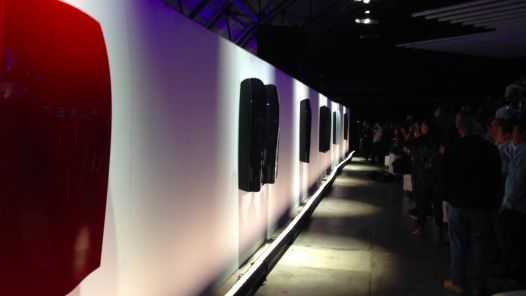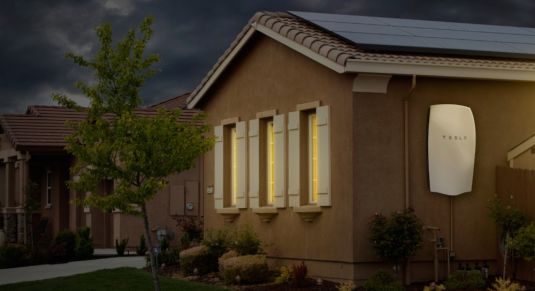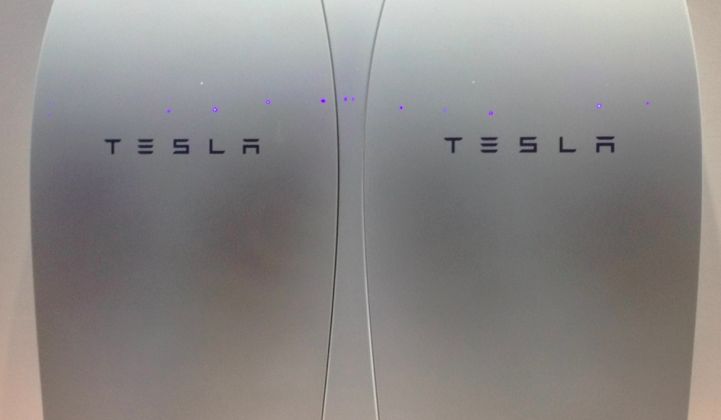The big reveal from Tesla Energy tonight: the company will charge $3,500 for a 10-kilowatt-hour energy storage pack that includes batteries, thermal management, and software. The price was the first thing that Elon Musk, Tesla CEO, told the gathered press corps and the 1,000 Tesla fans in attendance. (That price is the cost to installers and does not account for incentives. The price does not include the SolarEdge hybrid inverter.)
The audience actually whooped when Musk revealed the price.
Musk also said that the 100-kilowatt-hour industrial and utility units cost $250 per kilowatt-hour.
"There's nothing remotely at these price points," said Musk.
Musk called the Powerwall home battery packs "beautiful" and boasted of their non-intrusive size of 6 inches by 3 feet by 4 feet. JB Straubel, Tesla CTO, said that a key differentiation is the level of integration and 10-year guarantee. Straubel noted that the home battery packs have cell chemistries and control software designed for the demands of stationary storage.
When asked by this reporter whether the applications are backup or time-of-use arbitrage, Musk went a bit Kumbaya: "Our goal here is to fundamentally change the way the world uses energy at the extreme scale," adding, "The goal is the complete transformation of the entire energy infrastructure of the world to completely sustainable zero carbon." As to the answer to the question, the brain trust said, "Both."
Musk spoke of the allure of grid independence, reliable backup power, and the ability to gather cheap power at night to use or sell during the day. He suggested that 2 billion packs would be enough to transition the world completely to sustainable energy -- that's electricity, heating, and transport, according to the CEO.
Musk is the wrong person to bet against, but as Jeff St. John has reported, it's not quite as simple as that. Even at these remarkably low costs on an asset that will be leased, there are still some headwinds for Tesla. While demand shaving and time-of-day differentials might help some consumers save money in a perfect world, not all residential markets work for energy storage. (It certainly works in Hawaii -- SolarCity will be offering a get-off-the-grid package to Hawaiians in 2016.)
But utilities and PUCs are already reviewing rate cases and incentive rules to assess the value of residential energy storage and its imposition on the utility status quo.
SolarCity founder and CTO Peter Rive suggested in a recent blog post, "Proceedings currently underway, such as the New York REV and California’s More than Smart, seek the creation of effective market structures for distributed clean energy services that will reward utilities for adopting cheaper, cleaner, customer-sited resources. The products that we’re announcing today are the building blocks of these new market structures." He added, "I believe the best grid design is one in which utilities embrace distributed energy resources. However, when utilities and regulators impose solar-specific charges on their customers, or burden homeowners with unduly long system interconnection delays, utilities risk mass customer defection from the grid via solar battery systems."

The Tesla wall packs can be stacked up to nine units for a total of 90 kilowatt-hours' worth of storage.
Musk noted that Tesla will work with certified installers including SolarCity in leasing the energy storage units. The packs will be in limited production this year and will ramp up as the Giga factory comes on-line.

SolarCity announced that it would:
- Use the new Tesla battery in its DemandLogic energy storage system for commercial customers
- Incorporate the new Tesla battery into its GridLogic microgrid service
- Provide a turnkey battery backup service that includes permitting, installation and ongoing monitoring for residential customers

Some other tidbits about the battery system:
- Round-trip efficiency is >92 percent
- Tesla is working with Treehouse, electronics firm SolarEdge, demand response expert EnerNOC, and Green Mountain Power
- The industrial system has already been deployed at Amazon Web Services, Target and Jackson Family Wines
- Tesla's utility storage systems use 100-kilowatt-hour building blocks capable of 2-hour or 4-hour durations
As we've reported, the Silicon Valley company will have to compete with more established entities like LG Chem, AES Energy Storage and NEC/A123, as well as new entrants like Enphase, Sunverge, Sonnenbatterie, Alevo, Stem, and many others.
Energy storage in a garage is not yet a status symbol like a car or a watch. Can Elon Musk and the Tesla brain trust turn home battery backup and distributed energy storage into a fetish item like Tesla's sedan or Apple's iPhone?
The best parallel I can come up with is Nest Labs' transformation of the thermostat from an industrial beige circle into a smart learning platform. Nest has shown it can be done.
In the meantime, Tesla seems to have a formidable lead on price. Tesla Energy might be spun off as a separate entity from the parent -- if its marketing and engineering talent can really be applied to residential batteries.



